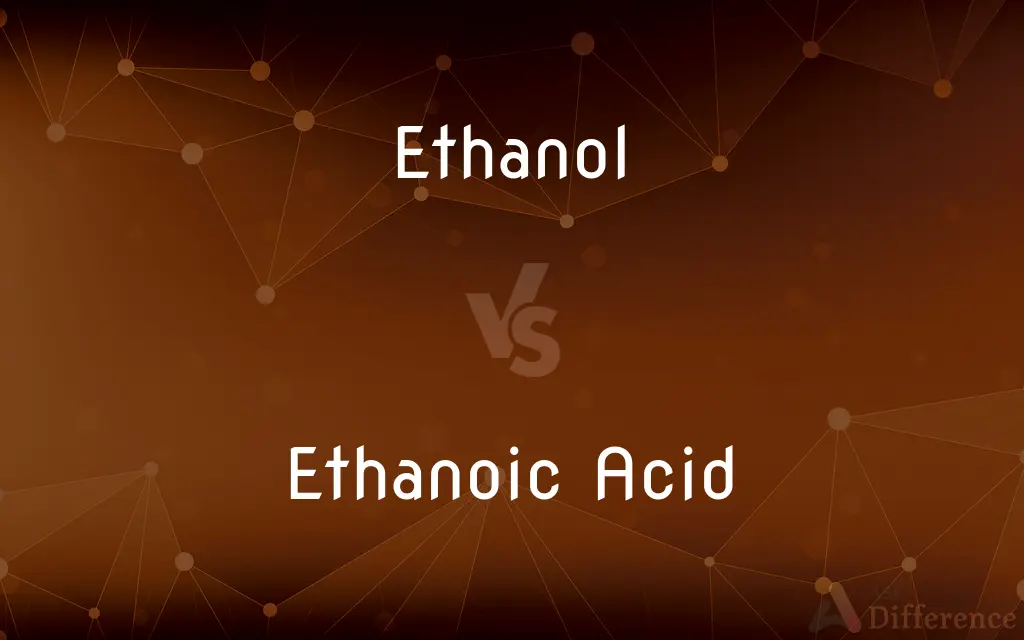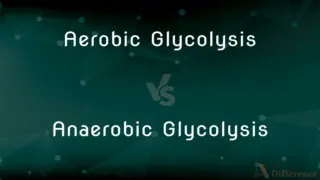Ethanol vs. Ethanoic Acid — What's the Difference?
By Tayyaba Rehman — Published on January 3, 2024
Ethanol is an alcohol with the formula C2H5OH, often used as a drinkable alcohol; Ethanoic Acid, also known as acetic acid, is a carboxylic acid with the formula CH3COOH, present in vinegar.

Difference Between Ethanol and Ethanoic Acid
Table of Contents
ADVERTISEMENT
Key Differences
Ethanol and Ethanoic Acid are both organic compounds with two carbon atoms in their molecular structure. While they share this similarity, their chemical properties and uses vary significantly. Ethanol is primarily recognized as the active component in alcoholic beverages, while Ethanoic Acid is the primary component of vinegar.
From a structural standpoint, Ethanol has an -OH (hydroxyl) functional group, categorizing it as an alcohol. Ethanoic Acid, on the other hand, contains a -COOH (carboxyl) functional group, classifying it as a carboxylic acid. This functional group difference dictates their respective chemical behaviors.
In terms of reactivity, Ethanol can be oxidized to produce Ethanoic Acid under specific conditions. This oxidation can be achieved using oxidizing agents like potassium dichromate. Conversely, Ethanoic Acid is the oxidized form and does not easily revert to Ethanol without specific reducing conditions.
Ethanol is a volatile liquid with a characteristic pleasant smell and is flammable. It's used in many industrial applications, including as a solvent and fuel additive (ethyl alcohol). In contrast, Ethanoic Acid has a pungent smell, is corrosive, and is utilized for various purposes, from culinary to industrial.
When considering their acidity, Ethanol is neutral and does not behave as an acid under normal conditions. Ethanoic Acid is acidic in nature and can donate a proton (H+) in aqueous solutions, resulting in its acidic properties.
ADVERTISEMENT
Comparison Chart
Molecular Formula
C2H5OH
CH3COOH
Functional Group
Hydroxyl (-OH)
Carboxyl (-COOH)
Common Uses
Alcoholic beverages, fuel additive, solvent
Culinary (vinegar), industrial processes
Chemical Behavior
Can be oxidized to Ethanoic Acid
Oxidized form, doesn't easily revert to Ethanol
Acidity
Neutral
Acidic
Compare with Definitions
Ethanol
A volatile, flammable liquid.
Due to its flammability, Ethanol is used in hand sanitizers and as fuel.
Ethanoic Acid
The acid component of vinegar.
The sour taste of vinegar is due to Ethanoic Acid.
Ethanol
An organic compound with the chemical formula C2H5OH.
Ethanol can be produced by fermenting sugars.
Ethanoic Acid
A carboxylic acid with the formula CH3COOH.
Pure Ethanoic Acid has a pungent smell and is corrosive.
Ethanol
A two-carbon alcohol used in beverages.
Beer and wine contain varying amounts of Ethanol.
Ethanoic Acid
A weak acid used in the food industry and in labs.
Ethanoic Acid is used as a preservative in some foods.
Ethanol
The primary type of alcohol found in alcoholic drinks.
The intoxicating effects of alcoholic drinks come from Ethanol.
Ethanoic Acid
A compound with both industrial and culinary applications.
Apart from its use in vinegar, Ethanoic Acid is used in the production of synthetic fibers.
Ethanol
A solvent used in many industrial and laboratory applications.
Ethanol is often used to dissolve various substances in labs.
Ethanoic Acid
An organic acid also known as acetic acid.
Ethanoic Acid is produced when Ethanol is oxidized.
Ethanol
See alcohol.
Ethanol
(organic compound) A simple aliphatic alcohol formally derived from ethane by replacing one hydrogen atom with a hydroxyl group: CH3-CH2-OH.
Ethanol
Specifically, this alcohol as a fuel.
Ethanol
The organic compound C2H5.OH, the common alcohol which is the intoxicating agent in beer, wine, and other fermented and distilled liquors; called also ethyl alcohol. It is used pure or denatured as a solvent or in medicines and colognes and cleaning solutions, or mixed in gasoline as a fuel for automobiles, and as a rocket fuel (as in the V-2 rocket).
Ethanol
The intoxicating agent in fermented and distilled liquors; used pure or denatured as a solvent or in medicines and colognes and cleaning solutions and rocket fuel; proposed as a renewable clean-burning additive to gasoline
Common Curiosities
Is Ethanoic Acid the same as acetic acid?
Yes, Ethanoic Acid is another name for acetic acid.
Why does vinegar have a sour taste?
The sour taste of vinegar is due to its Ethanoic Acid content.
Can Ethanol be transformed into Ethanoic Acid?
Yes, Ethanol can be oxidized to produce Ethanoic Acid using specific agents.
Is it safe to consume pure Ethanoic Acid?
No, pure Ethanoic Acid is corrosive and should not be consumed directly.
Is Ethanol acidic like Ethanoic Acid?
No, Ethanol is neutral, while Ethanoic Acid is acidic.
What's the difference between their functional groups?
Ethanol has a hydroxyl (-OH) group, while Ethanoic Acid has a carboxyl (-COOH) group.
Is Ethanol used in cleaning products?
Yes, Ethanol is a common ingredient in hand sanitizers and disinfectants.
What is the main component of alcoholic drinks?
Ethanol is the primary component responsible for the intoxication in alcoholic beverages.
What's the relation between wine and Ethanol?
Wine contains Ethanol, which results from the fermentation of sugars in grapes.
Can Ethanoic Acid be used for cooking?
Yes, Ethanoic Acid is a primary component of vinegar used in cooking.
Can Ethanol be used as a fuel?
Yes, Ethanol is often used as a biofuel and fuel additive.
How can Ethanoic Acid be produced in a lab?
Ethanoic Acid can be produced by oxidizing Ethanol with an oxidizing agent.
Which of the two compounds is flammable?
Ethanol is flammable, while Ethanoic Acid typically isn't under normal conditions.
Can Ethanoic Acid be reduced to Ethanol?
With specific reducing agents and conditions, Ethanoic Acid can be reduced to Ethanol.
Share Your Discovery

Previous Comparison
Aerobic Glycolysis vs. Anaerobic Glycolysis
Next Comparison
Golden Rice vs. Normal RiceAuthor Spotlight
Written by
Tayyaba RehmanTayyaba Rehman is a distinguished writer, currently serving as a primary contributor to askdifference.com. As a researcher in semantics and etymology, Tayyaba's passion for the complexity of languages and their distinctions has found a perfect home on the platform. Tayyaba delves into the intricacies of language, distinguishing between commonly confused words and phrases, thereby providing clarity for readers worldwide.












































